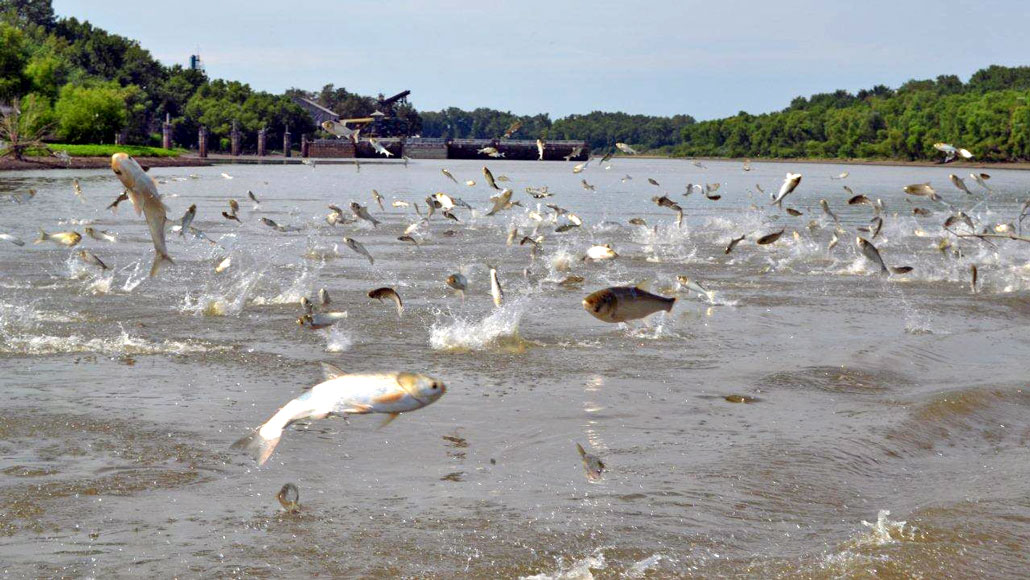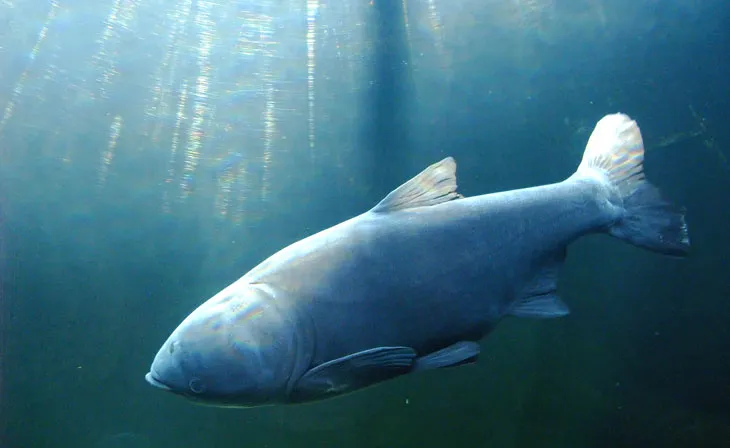
HOLY CARP If Asian carp (silver carp, Hypophthalmichthys molitrix, shown) reach Lake Michigan, there might be enough food for the fish to survive there as long as they aren’t picky eaters.
Asian Carp Regional Coordinating Committee/Flickr (CC BY 2.0)
- More than 2 years ago
If invasive carp reach Lake Michigan, a buffet of mussel poop and other junk food could help the fish survive and spread.
Once thought to be a food desert for these fish, the lake may provide enough nutrition for two Asian carp species, bighead (Hypophthalmichthys nobilis) and silver carp (H. molitrix), thanks to their not-so-picky eating habits, researchers report August 12 in Freshwater Biology. That’s bad news because the carp, which have spread to the Illinois River since their introduction to the United States in the 1970s, are just a human-made waterway away from getting into Lake Michigan.
“We should be doing everything we can to keep bighead and silver carps out of the Great Lakes,” says Sandra Cooke, a freshwater ecologist at High Point University in North Carolina who was not involved with the work. If carp gain a finhold, their populations could eventually take off, with difficult-to-predict consequences for the lake’s ecosystem. It’s a familiar trajectory for invasive species (SN: 3/18/17, p. 30). “Time and again, what we actually observe is worse than what we predicted in the first place,” she says.
Earlier studies, including by Cooke, suggested that these fish could survive in some nearshore spots, based on levels of carp’s preferred food, microscopic algae known as phytoplankton, in the top meter of water. But when better options aren’t available, carp will eat detritus, including fish poop or decomposing dead organisms, says Peter Alsip, a freshwater ecologist at the Cooperative Institute for Great Lakes Research at the University of Michigan in Ann Arbor. In fact, he says, the scrappy fish can subsist entirely on the low-quality food that comes from mussels’ fecal pellets and regurgitated particles.
In the new study, Alsip and his colleagues used water temperature, depth, available nutrition, the fishes’ appetite — including for junk food — and their energy needs to simulate where in the lake the carp could reside. Invasive zebra and quagga mussels cover much of the lake floor, presumably creating a “huge portion” of the detritus in the lake. So carp may be able to survive in much more of the lake than previously thought, Alsip says.

For instance, if bighead carp consume mussel poop and zooplankton in addition to phytoplankton, the surface area corresponding to where the fish could live quadruples on average during the warmest months of the year. Simulations show that the habitable area grows from 11,144 square kilometers to 43,308 square kilometers — about three-quarters of the entire lake. The habitable area for silver carp could double from 1,436 square kilometers to 2,758 square kilometers, the analysis found.
Rather than taking up residence in the middle of the lake, the carp may be more likely to treat the widespread detritus as sustenance to cross the massive lake to areas with better food. It would be as if “these fish want to drive on the interstate and they’re looking for a Cracker Barrel or some other food,” says Jim Garvey, an aquatic ecologist at Southern Illinois University in Carbondale, who was not involved with the study.
Bighead and silver carp were brought to the United States in the 1970s to control the growth of algae, which flourished on pollution dumped into streams. But during floods, the fish escaped their holding ponds. By the 1980s, it was clear the carp were spawning in the wild. The invasive fish are now found throughout the Mississippi River Basin, including on the Great Lakes’ doorstep. In the Illinois River, carp now account for nearly two-thirds of the fish biomass, research by Garvey and others has found.
Predicting when or how an invasive species will establish itself is difficult, Garvey says. “There are always surprises.” Tackling a complex lake ecosystem with such detail moves in the right direction by looking at where the fish might thrive, he says.






